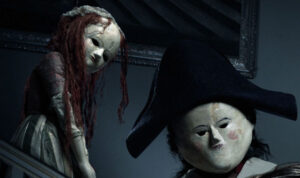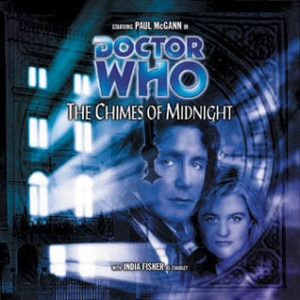Are Doctor Who’s Monsters Only Scary Due to the Music?
Guest contributors Isaac Bowen and Yossi Pinkus investigate.

There are many things we take for granted when it comes to Doctor Who, but quite often we forget the power of music. Notes that can make us outraged with the Master’s latest evil scheme, or cry at the loss of our favourite Doctor; it is the score of the episode that reigns supreme time and time again. It is due to the likes of Murray Gold, Dudley Simpson, Mark Ayres, Dominic Glynn and many many more, that monsters in Doctor Who can be made either scary or just plain silly.
 The classically hair-raising story everyone looks to of course is Blink. This episode introduced us to the Weeping Angels, considered by most to be one of Doctor Who’s most fearsome creations. But what made them so petrifying? For us, it was the music. At first, use of atmospheric sounds established the dark tone. But when it came to Sally facing off with the stone horrors, it was those harrowing strings that sent shivers down your spine.
The classically hair-raising story everyone looks to of course is Blink. This episode introduced us to the Weeping Angels, considered by most to be one of Doctor Who’s most fearsome creations. But what made them so petrifying? For us, it was the music. At first, use of atmospheric sounds established the dark tone. But when it came to Sally facing off with the stone horrors, it was those harrowing strings that sent shivers down your spine.
In contrast, The Angels Take Manhattan was nowhere near as frightening. There is a reason for this: the tone of the music. While Blink contained a distressing tone, Angels takes a more sombre, melancholy one, to compliment the more emotional plot of the Ponds’ exit(s). And when the soundtrack was not making you want to shed some tears, the tone was similar to that of an action movie; fast paced and urgent. These two episodes, while both featuring the same monster, are very different in terms of fear factor, leading us to point our fingers at the score.
 A lack of music can also create a sense of unease and tension. Listen, is the prime example. Although it may provoke controversy over many points, most will agree that it is a terrifying episode. What is unique about Listen is that one of its single most frightening images is that of a red blanket. Naturally, then, it was not the potential monster that was scary, but the distinctive and often subtle soundtrack. Its elusive undertones create the perfect setting to transform any object, however mundane, into the perfect Doctor Who monster to have the whole family shaking in terror.
A lack of music can also create a sense of unease and tension. Listen, is the prime example. Although it may provoke controversy over many points, most will agree that it is a terrifying episode. What is unique about Listen is that one of its single most frightening images is that of a red blanket. Naturally, then, it was not the potential monster that was scary, but the distinctive and often subtle soundtrack. Its elusive undertones create the perfect setting to transform any object, however mundane, into the perfect Doctor Who monster to have the whole family shaking in terror.
 Now, take the episode Night Terrors. The concept behind peg dolls that shamble toward you and turn you into one of them purely by touch is a positively scary idea. The tension mounting to the reveal in the dollhouse should leave you on the edge of the seat, or even behind it. But once the score kicks in, all tension is lost. Its whimsical tone, with nursery rhyme style leitmotifs, dull the menace of the dolls right down into figures of mild amusement; watch them clumsily stumble past a door or get jabbed with comically oversized objects. We can’t help but wonder how much better the story would have been with some haunting strings, or perhaps no score at all, letting the eerie, diegetic atmosphere shape these dolls into the stuff of nightmares. Mark Gatiss has recently said that his new script for Series 9 is his most scary yet. Hopefully it’s backed by a score that reflects this.
Now, take the episode Night Terrors. The concept behind peg dolls that shamble toward you and turn you into one of them purely by touch is a positively scary idea. The tension mounting to the reveal in the dollhouse should leave you on the edge of the seat, or even behind it. But once the score kicks in, all tension is lost. Its whimsical tone, with nursery rhyme style leitmotifs, dull the menace of the dolls right down into figures of mild amusement; watch them clumsily stumble past a door or get jabbed with comically oversized objects. We can’t help but wonder how much better the story would have been with some haunting strings, or perhaps no score at all, letting the eerie, diegetic atmosphere shape these dolls into the stuff of nightmares. Mark Gatiss has recently said that his new script for Series 9 is his most scary yet. Hopefully it’s backed by a score that reflects this.
 The use of music did not only start in the 2005 revival, however. There are many examples of Classic Series stories employing similar musical techniques to get the frightened juices flowing, such as the 7th Doctor masterpiece The Curse of Fenric. Now, while some may say that the story already had a bleak and grim undertone, it was the music that took this story to the next level. The many tense scenes featuring the attacking Haemovores, gruesome and ravenous though they are, were added to greatly by the striking accompanying themes; not a moment passed where they didn’t feel like a genuine threat. The harsh timbre of the music also adds great weight to the story, giving a real sense of pressure to the Doctor’s struggle against Fenric.
The use of music did not only start in the 2005 revival, however. There are many examples of Classic Series stories employing similar musical techniques to get the frightened juices flowing, such as the 7th Doctor masterpiece The Curse of Fenric. Now, while some may say that the story already had a bleak and grim undertone, it was the music that took this story to the next level. The many tense scenes featuring the attacking Haemovores, gruesome and ravenous though they are, were added to greatly by the striking accompanying themes; not a moment passed where they didn’t feel like a genuine threat. The harsh timbre of the music also adds great weight to the story, giving a real sense of pressure to the Doctor’s struggle against Fenric.
 The Classic Series is not without its musical qualms either. A key example of this is the 3rd Doctor romp Doctor Who and the Silurians. Now, while men in rubber suits may not pass as convincing reptilian bipeds, it is not helped at all by the overuse of the annoying kazoo blasting over the top of every suspenseful moment. What should have been gripping cliffhangers became something almost amusing; a common issue with the soundtracks of the Pertwee era.
The Classic Series is not without its musical qualms either. A key example of this is the 3rd Doctor romp Doctor Who and the Silurians. Now, while men in rubber suits may not pass as convincing reptilian bipeds, it is not helped at all by the overuse of the annoying kazoo blasting over the top of every suspenseful moment. What should have been gripping cliffhangers became something almost amusing; a common issue with the soundtracks of the Pertwee era.
 Now, it would be remiss of us not to mention the fine works of Big Finish here, when their entire stories hinge on the effective use of sound alone. With the power of imagination working in their favour, the effect of a score is ramped up to eleven in these audio dramas. Where Daleks and Cybermen are considered exciting, but not necessarily scary in the 2005 revival, Big Finish have been able to command notes to make even the most constantly recycled alien threats creepy once more. Stories such as The Final Phase, The Genocide Machine and Jubilee refresh those Skarosian xenophobic blobs and instil an unadulterated sense of dread. Eerie atmospheric music, or lack thereof, has triumphed in Cybermen stories too, such as Spare Parts and The Reaping, both of which are extremely distressing in nature. Big Finish also has the power to make anything as ordinary as a house into a terrifying and unsettling killing machine, as seen in The Chimes of Midnight. We challenge you to listen to this story at midnight, alone, as we each did, and not be left shivering, teeth achatter. The score seeps with sinister tones.
Now, it would be remiss of us not to mention the fine works of Big Finish here, when their entire stories hinge on the effective use of sound alone. With the power of imagination working in their favour, the effect of a score is ramped up to eleven in these audio dramas. Where Daleks and Cybermen are considered exciting, but not necessarily scary in the 2005 revival, Big Finish have been able to command notes to make even the most constantly recycled alien threats creepy once more. Stories such as The Final Phase, The Genocide Machine and Jubilee refresh those Skarosian xenophobic blobs and instil an unadulterated sense of dread. Eerie atmospheric music, or lack thereof, has triumphed in Cybermen stories too, such as Spare Parts and The Reaping, both of which are extremely distressing in nature. Big Finish also has the power to make anything as ordinary as a house into a terrifying and unsettling killing machine, as seen in The Chimes of Midnight. We challenge you to listen to this story at midnight, alone, as we each did, and not be left shivering, teeth achatter. The score seeps with sinister tones.
There is strength in a note; in a melody, and an episode’s score reflects this. We leave you with this proposition: Music is powerful enough, that given the right notes, even the Kandyman himself could become the stuff of nightmares.








